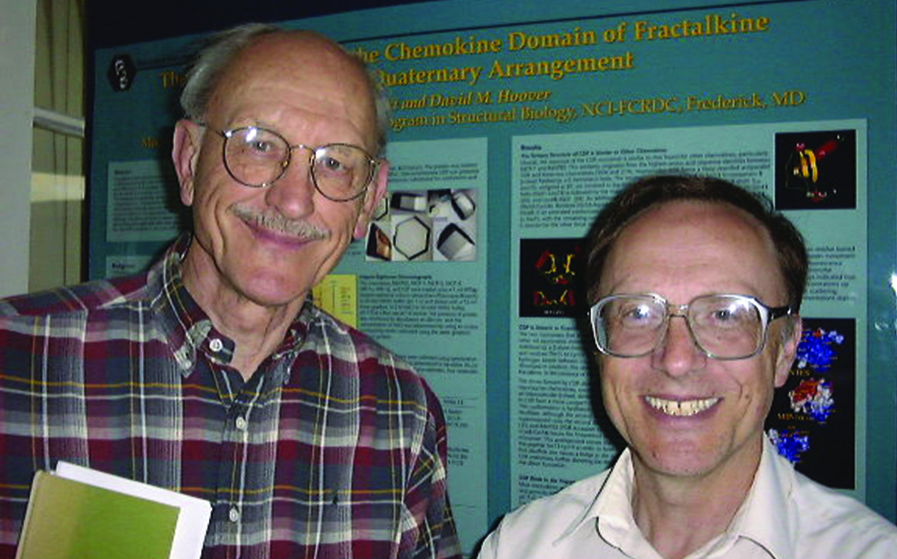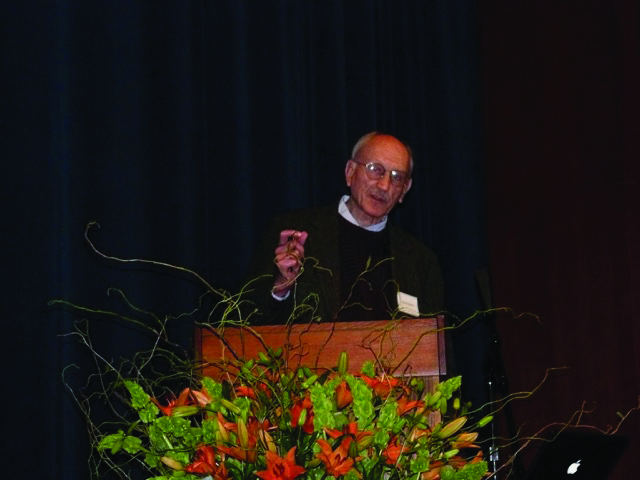Alex Wlodawer: I met David for the first time almost exactly 40 years ago. I was introduced to him during a Gordon Conference by Hal Wyckoff, who recommended me as a candidate for an open position in macromolecular neutron crystallography at the National Bureau of Standards. At that time I knew that David was well-known for his work on the structure of antibodies, but his relationship to the neutron project was a bit puzzling to me. Only later, when I got the job, which ultimately involved working both at NBS and NIH, did I realize that David was a truly remarkable and generous person: although he took a keen interest in the field of application of neutrons to protein crystallography and funded the project from his own laboratory resources, he never interfered with it. During the eight years I spent at NIH in Bethesda he left the conduct of the project entirely to me and he never put his name on any of the resulting publications. After a while he also provided me with a postdoctoral fellow position (nominally his), but again without taking any credits for his (and later her) accomplishments. On the other hand, he was always there when I needed scientific or any other advice; his knowledge of crystallography was simply incredible. Such a level of generosity in the interest of science is very rare, and this is one of the reasons why those of us who had the privilege of knowing him and interacting with him will miss David so much.
David spent some time in Cambridge (UK) during the incredibly exciting period when the first protein structures were being determined. In that way he became one of the pioneers of the field and contributed to its development in a very significant way. Who could predict that the structure of rhisopuspepsin that was determined in his laboratory in the mid-1970s would become crucial a decade later for the clarification of the structure and function of HIV protease, the first structure-based target for the design of drugs against AIDS? David himself became directly involved in the HIV-related projects by solving the first structure of the catalytic domain of HIV integrase, another key drug design target. Other important projects, some carried out until quite recently, involved very challenging studies of tryptophan synthase, Tol-like receptors, and TGF-beta, to mention just a few. The latter structure was very important to me personally, since a few months prior to its publication Tom Blundell published the structure of nerve growth factor, a result of a long collaboration between his and my laboratories. We proposed in that paper that NGF contains a cystine knot, an unusual topological feature never observed before, but we were rather concerned about the correctness of our structure in view of the limited quality of the available diffraction data. However, the topology of TGF turned out to be the same as that of NGF and we were much relieved.

David Davies and Alex Wlodawer
Although I moved out of the attic of NIH Bldg. 2 in the mid- 1980s, I never lost touch with David. His stature as the most accomplished structural biologist at NIH helped convince the leaders of that institution to fund the inter-institute project that has provided access to synchrotron beamlines, first at Brookhaven and now at Argonne. Most importantly, it was my fortune and true privilege to be able to learn from David. Although we wrote only one paper together (a 1995 review of cytokines and their receptors), I benefitted enormously from knowing this remarkable scientist.
His passing closes an important chapter in the development of macromolecular crystallography as a tool and as a discipline concerned with the most important molecules of life.
Bob Stroud: David Davies is for me, one of the finest examples of positive cooperativity in science and in life. I met David for the first time in 1969 when he visited Caltech. I was a newly arrived postdoctoral, from J.D. Bernal's group in London, where I had worked on direct methods solutions to nucleoside antibiotics. David was already an established lab head at the NIDDK. I was thrilled to have joined Richard Dickerson’s laboratory. Dick had been key to the myoglobin structure from John Kendrew’s laboratory, and I was to determine the structure of bovine trypsin with Dick. David had also worked extensively on nucleotide pairings and was determining the structure of gamma-chymotrypsin, named because it crystallized in the ‘active’ pH range in space group P42212. David was so genuinely enthusiastic and supportive of our efforts with closely related trypsin; he was so encouraging and calmly excited as to what would be a fascinating comparison. All these early proteins came from natural sources; usually cows, whales, or horses! And he was so completely excited by the potential of structural biology for the future. From our first meeting he became one of the most formative influences in my scientific life; someone who was always interested in the answers and looked forward to other's successes with anticipation. He was instantly the kind of person who, if you hit a good point against him at tennis, far from being dismayed would say, and mean, well done!
Parts of our parallel heritage, frame-shifted in time, we shared on many occasions; David grew up in the coal mining area of South Wales, and I 200 miles north near the coal mining areas of Lancashire England. He had gone to Oxford and I to Cambridge. We both had to learn new accents! David had been at Caltech at a very exciting period in structural biology. He was there with Linus Pauling and Bob Corey soon after they proposed the alpha helix and the beta sheet in 1951. David was at the historic Caltech meeting when in 1953 Perutz and Ingram, working in Cambridge on horse hemoglobin, reported the mercury position in two dimensions, first showing that protein structures could be determined! Crick showed that twisted helices could account for the peaks seen at 5.1Å rather than the 5.4Å expected from the pitch of the Pauling model. 1952 was also a landmark year for direct methods: the Sayre equation, Karle and Hauptman, Cochran, and Zachariasen. David was a true pioneer of discovery building on these discoveries from the birth of protein structural crystallography until today.
David’s heritage lives with us today at UCSF. When David went to the NIDDK/NIH along with Gordon Tomkins, Gary Felsenfeld, Bruce Ames and Harvey Itano, they had decided with Gordon as their lab head, to have joint meetings such that they all shared their insights and vision. Gordon later joined Bill Rutter in founding the current version of the Department of Biochemistry and Biophysics here at UCSF. This tradition was imported by Gordon and Bill to UCSF and is still the essence of our institution. Now the room is packed with 80 faculty members, but the principles that David Davies, Gordon Tomkins and Bill Rutter et al. started are at the core of UCSF today.
David loved science and was a key figure in structural biology from his early undergraduate days at Oxford as a crystallographer with ‘Tiny’ Powell, and next door to Dorothy Hodgkin’s lab, to publications with John Kendrew, and Richard Dickerson on myoglobin in 1960 that led to the Nobel Prize for Kendrew and Perutz for the first structure of myoglobin and its evolutionary cousin hemoglobin, to today.

And he loved life in balance: reflected in his love for family, the garden and the mountains, for sailing and the sea, and for tennis. I visited his home in Bethesda in the 1970s. He walked me through his lovely garden on a cold spring afternoon, and pointed out one small struggling medicinal plant that he seemed very pleased with! One of David’s favorite stories involved his love of the garden. I had moved from Caltech to UCSF in San Francisco in 1977 with children tearing around. We had found a place to live, with, as it happened, three conjoined greenhouses in the back corner of the garden. The previous owner had won numerous prizes for his amazing orchid collection that had long since been transported to the San Francisco Arboretum. David came to stay at our new house. He pondered the garden. Gardens are somewhat a source of pride in England and Wales though I had never caught on in this area, but I was pleased that David asked to walk around the garden. We walked around, I somewhat pleased to see his interest, and his incredible knowledge of these leafy species. It was a leafy glade with, lo and behold, exotic plants and trees imported from far off countries by the previous Scottish horticulturalist. I had no idea! He asked what was inside the greenhouses. I had barely looked inside, but I knew that the next-door neighbor's 13 year old had asked my wife if he could use the greenhouses to grow his marigolds. His father, a local lawyer, described him as the ‘Marigold King’ and my wife had agreed, so I vaguely knew that there might be some marigolds. I mentioned the ‘Marigold King’ to David and when I pried open the door, we were greeted with over a hundred plastic containers in a phalanx array, each with a perfect leafy marijuana plant. 100 very healthy clones growing in sync! David was amused beyond belief - he enjoyed the thrill ever since! So much better than the plant he showed me in his own garden struggling through the Bethesda winter!.. Those were less tolerant days than today. My young neighbor went on to a great career in agriculture, and his lawyer father never knew.... But David never failed to remind me of the Marigold King!
David is also well known for his vast impact on immunology over several decades. He determined landmark structures of antibody Fab fragments complexed to lysozyme, and ‘cryoglobulins’: whole antibodies from myeloma patients. In 2008 his interests in innate immunity led to his ‘Structural basis of Toll receptor signaling’. It was a major recent breakthrough!
Our scientific interests overlapped again in the structures of HIV integrase where David, Bob Craigie and Fred Dyda obtained a structure of the catalytic core dimer in 1994, followed by bound inhibitors and mechanistic roles for the metal ions in 1998/1999. We had been working for many years with Harold Varmus in vain trying to prepare and crystallize complexes of the multi-domain integrase and complexes with DNA. This was not for the faint of heart! David and I would often resonate on the problems, and eventually with Andy Leavitt we added other mutants to Craigie’s ‘solubility’ mutant and obtained the first structure of two of the three domains, the dimer of core and C-terminal DNA binding domain in 2000.
David remained an incredibly warm and inspirational figure who was a key driving intellect from the beginnings of the x-ray crystallography of proteins. He traced his experiences in a very personal and enlightening recollection
A Quiet Life with Proteins, published in the
Annual Reviews of Biophysics and Biomolecular Structure 2005
34 1-20 that is available
here.
Above all David Davies consistently augmented the sum of the parts to be so much more. He brought humor and enthusiasm to science and an amazing balance to life at the forefront of discovery. He made profound discoveries in the fundamentals of protease mechanisms, the fundamentals of antibodies in the immune system, HIV integrase, innate immunity and more. For me personally he is a reminder of the thrill of a life in science surrounded by those we love and admire, where every day is newly defined by discovery, and where the possibilities are limited only by our imagination.